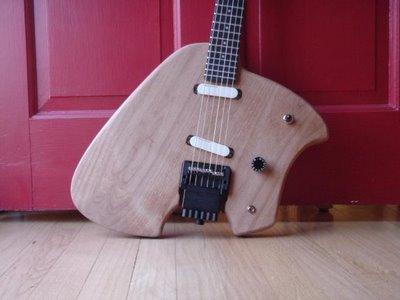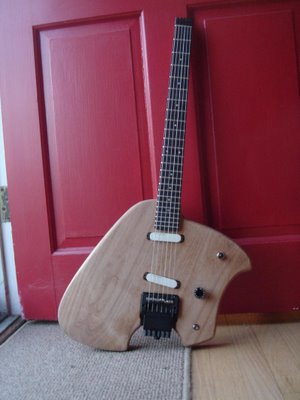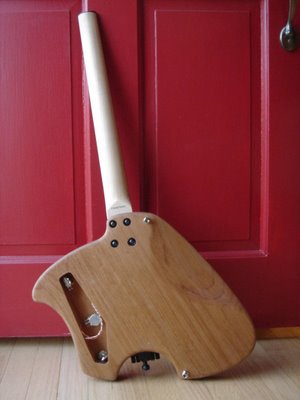Klein Style Electric Guitar Project #1
With the electric guitar body finished, it was time to begin my guitar project’s final assembly. While I was at it, I loaded in the guitar’s switch, volume and output jack to see how the guitar will look in its final state.

As you can see, I kept the guitar’s electronics simple. Gold Lace Sensor pickups are at the neck and bridge position with a 3 position Gibson style switch to control them. I opted for a single volume control with no tone control although there is room to add one later on. Finally, the output jack is surface mounted so that it isn’t in the way when sitting in classical position. The guitar will be complete once I…
- adjust it for intonation
- adjust the pickup height
- make a control cavity cover
- shield and wire the control cavity
Here are a couple of full views – front and back:


Once I complete the remaining tasks, it will be time to start planning the next build…
Here are posts on the rest of my first guitar project:
- Danish Oil Finish Applied
- Control Cavity and Pickup Routes Complete
- Guitar Belly Contour and Forearm Cut Complete
- Guitar Neck and Steinberger Bridge First Test!
- Guitar Neck Pocket Complete
- Guitar Bridge and Neck Arrived
- Guitar Body Flush Trimmed and Edges Rounded Over
- Cutting Out The Ergonomic Guitar
- Making The Ergonomic Guitar Template
- Project Guitar Topic Thread: First Project Attempt – Ergonomic Guitar
Robert it looks great! I love how naked and purpose driven it appears. On the other hand I’d have filled that control cavity with switches and knobs straight off, but I’m just like that.
Thought i’d mention to you that Musicyo is now selling parts for their Steinberger Synapse models. The bridge is hardtail and the headpiece will take ball end or regular strings. prices are very reasonable for headless hardware. Just a little info for the next on.
Hi Matt! Good to see you. I’ve been looking at the Synapse components since the next build will be a fixed bridge. I would consider the bridge with piezo pickups for acoustic tones.
I’m with you on the single volume and no tone control. Tone controls are usually a complete waste of time anyway. Have you opted for no scratch-plate?
Hey GL – I worked on several pickguard designs but I wasn’t particularly happy with any of them. I was trying to avoid the Klein solution which involves both top routing and rear routing – the top pickup and switch are in a pickguard while the rest of the electronics are rear routed. I ended up opting for the rear route instead. However, I may still visit the idea in a future design or consider a smaller scratchplate that doesn’t necessarily involve any of the electronics.
I wish the Synapse bridges weren’t fixed. When I found out the entire line was fixed bridge, I was pretty disappointed!
Robert, this is looking great. I’m a big fan of purpose-driven design as matt says.
Greg
Hey Greg! Unfortunately, there aren’t very many options if you’re looking for a headless with tremolo. On the other hand, there are several workable solutions for fixed bridge designs. I’ll be looking toward one of these for the next design.
As far as the look of the guitar, I lean toward a “form follows function” aesthetic thus the minimalist layout.
that sir is a work of Art.!!!!
MERRY XMAS:)
Hello Wally and thank you! That is certainly high praise. Happy Holidays!
I first saw a Klein in Guitarist magazine (around 1990)and had a friend enlarge a colour copy of it. I bought a second-hand Hohner GT3 for peanuts the same year and hatched a plan to cobble together a Klein. Made a body out of mahogany and prepared the neck but that’s as far as it got – the trem fractured at the point it sits in the body.
Really pleased someone’s gone ahead and built one, especially as it would seem Klein Electrics are doomed. Congratulations!
Andrew
Hi Andrew! Thanks! I’ve enjoyed the process. To the best of my knowledge, there have only been a handful of successful Klein-based builds by amateur builders. I’m fortunate to count myself among them. 🙂
Very, very clean. Great job! Do you keep an archive of any further exploits you’ve had with this guitar? Are you still happy with it, etc? Any changes you’ve made since birthing it? Newbie Brad PS I wish I could wave a magic wand and build one like it as a fretless, that’s my flavor guitar since a few years now.
Welcome to the site, Newbie Brad!
At the moment, you can click on Guitar Build #1 (also listed in the Topics section) to see all of the articles related to this project.
Among my to-do’s are several follow-up articles related to just those questions – experience to date, suggested improvements, etc.
Longer term my intent is to do some prototyping of ideas. At the moment, I’m working on coming up with time efficient methods of doing this. So I’m exploring a number of venues.
Hope that helps and stay tuned!
A friend sold me a spirit (left hand). I have been playing it upside down. Does anyone have leftover spirit bodies like the one you took apart that they no longer want? I am happy with the stock body style you took the parts off of (as is. I just want to get a right hand body in the diiferent wood types so I can play right side up for me.
fascinated by your project.
Moller, in his Essay on Architecture, taught that the building which was fitted accurately to answer its end would turn out to be beautiful, though beauty had not been intended.
– Ralph Waldo Emerson
I think this is certainly true with this guitar design. Purposeful design, efficient AND as a result, a work of art.
I think devotion to traditional design is an anchor weighing the guitar industry down. I was given a Gibson Les Paul. it’s heavy, and ackwardly designed from an ergonomic perspective.
Question: does a light electric guitar sacrifice sustain?
@Craig C – Very interesting comment and agree with the statement wholeheartedly. I’m a big proponent of form follows function and I believe there is great beauty in solving a problem elegantly.
Light weight guitars don’t have to lack sustain. In fact, my guitar sustains better than many off the shelf guitars.
There are a lot of factors that go into an instrument’s sustain including quality of construction and construction techniques. For example, the Musicyo Steinberger I picked up for the neck, bridge and headpiece had a very sloppy neck pocket. As soon as I removed the screws, it simply fell out. In comparison, my guitar’s neck pocket is very snug – so much so that I could pick up the guitar by the neck without it being bolted in place! So right there, you have a much better mechanical connection and that is going to factor into sustain.
That’s just a small example but it should give you at least a small idea that there’s more to it than just building them heavy. 🙂 Come to think of it, there’s probably an interesting article in here…
Thanks for the comment!
Liking the guitar, I’m planning on building my own guitar and was just wondering how did you drill for the cables between the pickup cavities?
@Jonathan Booth – I picked up a 12″ drill bit and went through the neck pocket. But be careful! It doesn’t take much to go off track and end up drilling out the back.
What are you thinking of building?
@Mike J – Let me take a look. I may have a Steinberger guitar body laying around here somewhere. 🙂
Cheers for the advice. I’m planning on a solid alder body electric guitar and have a shape which I think should be very comfortable with a bit of luck, I’m just waiting on funds at the moment, I’ll post back when I have started. The guitar looks very good though, good job!
Jon.
Hey! Sorry to keep bothering you, just wondering what you grounded the wiring to? I know the bridge is the common favourite, but if you did ground it to the bridge, how did you do it? Cheers, Jon.